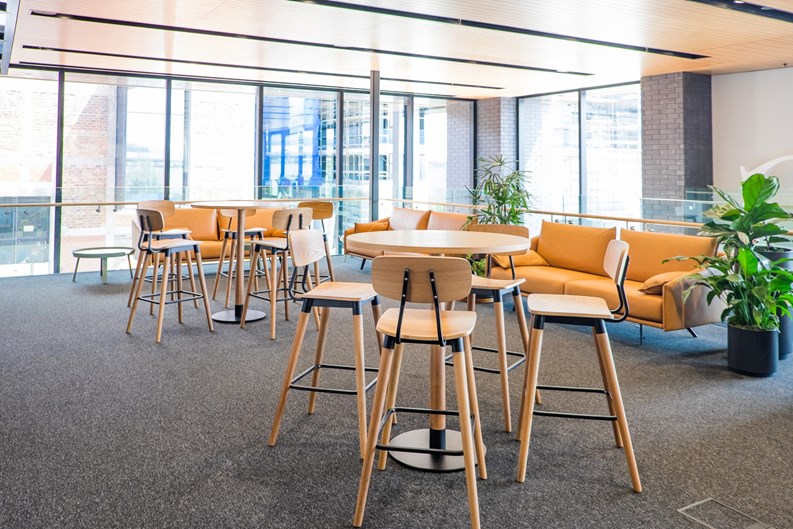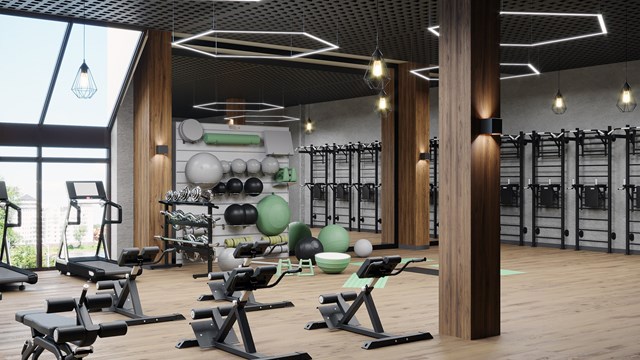The appeal of multifamily living is not just in the hands-off maintenance and shared general expenses that come with living in a co-op, condo, or HOA. It’s also in the sense of community and the on-site offerings that can be shared among neighbors. Amenities and social programming in co-ops, condos, and HOAs can distinguish one building or community from another and add to its popularity and property value.
Over the years, different types of amenities and programs have been bigger draws, and some offer more bang for the buck than others. The biggest paradigm shifter over the last decade has been the still-ongoing coronavirus pandemic. It has upended the way we live, work, and socialize, and its effects on our lived environments will be vast and long lasting.
Working from Home
While COVID-19 certainly amplified the need, desire, and ability for many to work from their homes, pros in the industry say that the shared-office space as a multifamily building amenity is not new by any stretch. Co-working space both in and out of residential buildings was gaining in popularity well before the coronavirus pandemic (you still there, WeWork?)—but, like with many other trends and changes, COVID’s presence expanded the demand and hastened the inclusion of such spaces as multifamily amenities, especially in new construction.
Jeremy Brutus is co-founder of URBN Playground, a full-service amenity consulting, technology, and staffing firm headquartered in New York City and serving clients around the country. He has observed an uptick in demand for work space, and has helped existing buildings and communities incorporate it in creative ways. “During COVID,” he says, “some residential buildings have designed and installed new office stations within their amenity spaces; others have retrofitted existing lounges and community rooms to stand up to the demands of the newly remote workforce.” He adds that integrating ‘prop-tech’—new technologies that add efficiencies, functionality, and service to properties—can enhance physical alterations by allowing remote booking, capacity management, and concierge services.
Earlier in the pandemic, designers at New York City-based ALine Studios predicted, “There will be demand for either flexible coworking spaces or single occupancy pods within residential buildings.” With limited space to build out new amenities, existing co-op and condo buildings can “create an amenity space that has flexibility for many different uses,” they suggest, by installing convertible furniture or furnishings that are easy to rearrange or to store away. Some examples they give include collapsible conference tables, segmental seating arrangements, pop-up desks, and modular wall panels.
That flexibility is still key in amenity design, say the pros, as the needs and wants of homeowners evolve along with considerations related to the pandemic (and the possibility of future ones). Residents aren’t returning to offices in droves, says Eric Mullendore, architect and interior designer based in Chicago … but now they are craving human interaction—or at least proximity.
“The remote workforce is seeking out places that have the comfort, convenience, and safety of home,” he says, “but that also provide the opportunity to connect and engage with others. [Co-ops, condos, and HOAs] can really capitalize on this by making or repurposing common areas into amenity spaces that accommodate both work and socialization.”
Home, or Hotel?
While offices nationwide have reopened and people are edging back into pre-pandemic routines, the appeal and convenience of working remotely have made owners of buildings of all types reconsider the functions and services they provide. Rental apartment buildings were particularly quick to adapt their amenity spaces in light of new lifestyle patterns, says Brutus, and many are incorporating spaces and services normally reserved for commercial applications.
“Even before the pandemic,” Brutus explains, “amenities and service previously associated with the hospitality industry had infiltrated the residential property sector. Now, as much of the world has grown accustomed to working remotely, commercial and office environments are being introduced into increasingly amenity-rich residential buildings. It’s increasingly clear that the future of real estate lies in curated spaces where the consumer can meet multiple needs.
“For the residential market,” continues Brutus, “this means that co-ops and condos are no longer viewed as just a home, but also as a place where the unit owner or tenant lives a larger proportion of their life. Can they exercise, socialize, even work in their building? Are there on-site services like dog walking, dry cleaning, housekeeping, and salons that help make busy lives easier?”
This is true in a variety of markets, including Las Vegas, where many would-be new homeowners are opting instead to rent. Industry pros cite a number of reasons for this: lack of inventory, skyrocketing home prices (and general inflation), jumps in interest rates, crushing student loan debt, and the peripatetic lifestyle that the millennial and younger generations are drawn to. If and when they do look to buy, particularly in a multifamily development, “Simply having a swimming pool or doorman doesn’t cut it anymore,” according to Jess Molasky, principal and project manager for Ovation Development in Las Vegas, Nevada. “Developers have to catch up to the latest technology and luxury amenities that the rental market has been providing.”
Upon Further Consideration …
It’s not as easy as one might think to convert an unused space to a gym or a co-working space or a dry cleaner, or even to build one from scratch. “As an architect creating these spaces,” says Antonio Argibay, founder and managing principal at Meridian, an architectural firm based in New York and Miami with clients nationwide, “you must consider ways to also create better lighting and ventilation for those areas. Much will depend on the neighborhood and potential market, too.” There are also local ordinances and restrictions that must be considered for some building uses, he says. Converting a space from a “dry” use (say, a storage room or yoga studio) to a “wet” one (think community café or salon) will open up a whole different set of considerations.
Then there’s the level of upkeep, equipment, and management that these types of amenities require. Speaking of wet uses, pools are always a big draw for buyers in most areas—but they come at a price. “A pool requires extra payroll,” says Carl Borenstein, president of Veritas Property Management in New York City. “It requires supplies, and you are required to have Board of Health inspections. You’re also required to deal with people—kids who are lifeguards, for example. You have to make sure they are actually doing their job.”
Maintaining a pool, both structurally and chemically, is also a hefty proposition. “If the item is a structure,” continues Borenstein, “it requires physical plant inspections, and sometimes repairs of problems like leaks. When I say ‘leaks,’ it’s not just the repair; sometimes water is lost, yet you are still paying for that lost water through your water bill. If an amenity is a structural element, that has to be maintained. I’ve heard of buildings with swimming pools that have collapsed because they weren’t maintained properly.”
Borenstein also points out that even very seasoned property managers may not have experience managing a pool, or a doggy daycare, or a tech-heavy coworking space. Each of these requires special knowledge, skills, and vendor connections. “A number of challenges arise in the management of amenities,” he notes.
Above & Beyond
In an increasingly volatile marketplace of ever-shifting buyer demands, some buildings and communities are incorporating amenities that truly change the paradigm for co-op, condo, and HOA living.
Argibay explains that outdoor space—a hugely popular amenity well before the pandemic—has taken on a whole new importance in the wake of COVID, which has prompted developers and boards to invest a lot into these areas. “There was always demand for both private space and community [outdoor] space,” he says. “That’s been a trend for at least 20 years—but COVID has thrown gas on that fire. Natural spaces with greenery are very desirable”—and now with a focus on their impact on climate change and the environment, buildings need to consider how amenities can reduce their carbon footprint as well.
“Buildings having green roofs are also a bonus,” continues Argibay, “as you get environmental benefits for it. New requirements [like Local Law 97 in New York City] will become prescriptive for more green roofs that include outdoor space for both resident use and energy efficiency.” He says he fully expects the trend toward private outdoor space in individual apartments as well as community-wide green spaces will continue to grow.
Dan Wollman, CEO of Manhattan-based property management firm Gumley Haft, concurs. “The top amenity co-op and condo residents desire in their buildings include some kind of common outdoor space. They seek an area where people—neighbors and their friends—can congregate. This could be a roof deck.” But, he cautions, “a roof deck must be in compliance with the rules of the Americans with Disabilities Act (ADA). If you can’t get to a roof deck, the building can’t have a roof deck. There are also issues with the load that a building’s roof can bear, which may make a roof deck moot.”
COVID has also accelerated the trend for ‘wellness’ amenities—sanctuaries, saunas, salons, and stretching rooms that could compete with the fanciest spas. “The last decade has ushered in an age of experiential amenities,” says Brutus. “Perks and services that were historically only available to very large buildings and hotels with vast amenity spaces have become expected—even demanded—in buildings of any size, in nearly any neighborhood. Many owners and renters alike are prioritizing services over space—and it shows.”
Up in the stratosphere of the most luxurious buildings, amenities that reflect the interests and lifestyles of their residents are taking hold, such as at several new condominiums in Manhattan and Brooklyn that, according to a recent New York Times article, have developed spaces for storing, consuming, sharing, and appreciating wine.
“Luxury buildings are creating a lifestyle and residents want these kinds of social opportunities,” Ari Goldstein, senior vice president at Extell Development Services, tells the Times. His company has created the wine selections for oenophile owners at Brooklyn Point and One Manhattan Square. “We’re responding to that demand,” he continues.
At 53 West 53, developer Pontiac Land Group built a double-height, octagonal shaped tasting room with a variety of tables, gold leaf ceiling, cork flooring, decorative wine cabinets and private temperature-controlled wine vaults, reports the Times. “We’re finding people want to entertain, but not necessarily in their apartment,” says chief marketing officer Samantha Sax. “Or they’ll have a glass of wine with friends in the tasting room and then go upstairs to their apartment for dinner.”
Sax captures this particular zeitgeist as she tells the paper, “Over the past few years people want more spaces to entertain and to feel like they are living in a hotel. The idea was for people to feel like they are on vacation.”
We’ll drink to that.
Darcey Gerstein is Associate Editor and a Staff Writer for CooperatorNews.










Leave a Comment